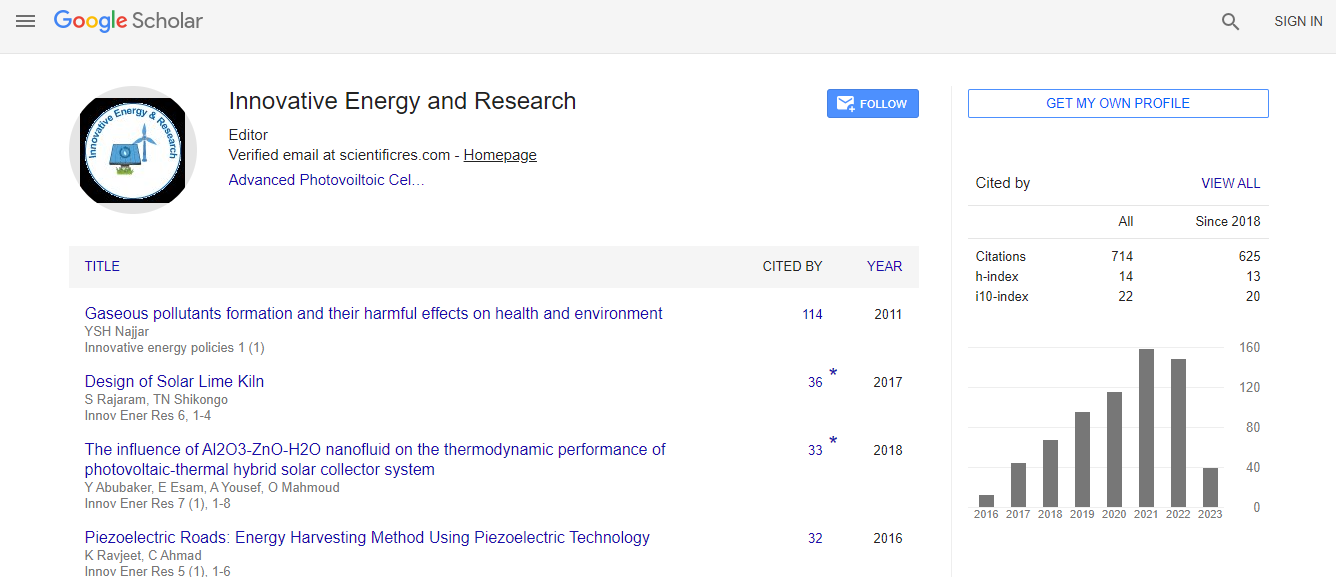Our Group organises 3000+ Global Conferenceseries Events every year across USA, Europe & Asia with support from 1000 more scientific Societies and Publishes 700+ Open Access Journals which contains over 50000 eminent personalities, reputed scientists as editorial board members.
Open Access Journals gaining more Readers and Citations
700 Journals and 15,000,000 Readers Each Journal is getting 25,000+ Readers
Google Scholar citation report
Citations : 712
Innovative Energy & Research received 712 citations as per Google Scholar report
Innovative Energy & Research peer review process verified at publons
Indexed In
- Google Scholar
- Open J Gate
- Genamics JournalSeek
- RefSeek
- Hamdard University
- EBSCO A-Z
- Publons
- Euro Pub
- ICMJE
Useful Links
Recommended Journals
Related Subjects
Share This Page
Extremely foldable and highly transparent nanofiber-based electrodes for liquid crystal smart devices
20th International Conference on Advanced Energy Materials and Research
In Chul Kim, Tae-Hyung Kim, Seung Hee Lee and Byoung-Suhk Kim
Department of Organic Materials & Fiber Engineering, Chonbuk National University, Republic of KoreaDepartment of BIN Convergence Technology, Chonbuk National University, Republic of KoreaDepartment of Polymer-Nano Science and Technology, Chonbuk National University, Republic of Korea
Posters & Accepted Abstracts: Innov Ener Res
Abstract
In recent years, flexible transparent electrodes have attracted great attention in many wearable optoelectronic devices, such as touch screens, organic light-emitting diodes (OLEDs), solar cells, electronic skins, etc. The basic requirements for foldable transparent electrodes are optical transparency, low electrical resistance, and high level of extreme bending toughness without significant decrease in the electrical performance. Generally, resistivity and optical transmittance follow opposite trends. It is therefore important to achieve the optimized balance between the electrical resistivity and optical transmittance in order to get a highly conductive transparent electrode. Traditionally, commercial indium-tin oxide (ITO) electrodes have been widely used in transparent conducting optoelectronic devices. However, there are still some disadvantages of ITO electrodes in flexible electronic applications, such as the scarcity of indium, the high cost of manufacturing processing, and their mechanical brittleness, which prompt the research for the alternative materials to replace the ITO electrodes for next generation optoelectronic flexible devices. In this work, the nylon 6 nanofiber-reinforced cellulose acetate (NF-r-CA) film as a fiber-based transparent substrate was used to develop the highly transparent electrodes with excellent durable and extremely foldable properties. The NF45-r-CA electrodes prepared using AgNWs concentration of 0.025 wt% and electrospinning time of 45 min were highly transparent (~ 90%), mechanically robust (59.6 MPa) and lower sheet resistance (20~30 Ω sq-1) even under extreme bending radius of 1 mm for 10,000 cycles. In addition, the NF-r-CA based PDLC (Polymer Dispersed Liquid Crystal) film could retain the working stability even after bending test of 500 cycles at an extreme bending radius of 1.5 mm, whereas ITO PDLC film was stopped working after bending test of merely 50 cycles. This result demonstrates the excellent foldable stability of NF-r-CA PDLC films at an extreme bending radius of 1.5 mm.Biography
E-mail: kbsuhk@jbnu.ac.kr

 Spanish
Spanish  Chinese
Chinese  Russian
Russian  German
German  French
French  Japanese
Japanese  Portuguese
Portuguese  Hindi
Hindi 
